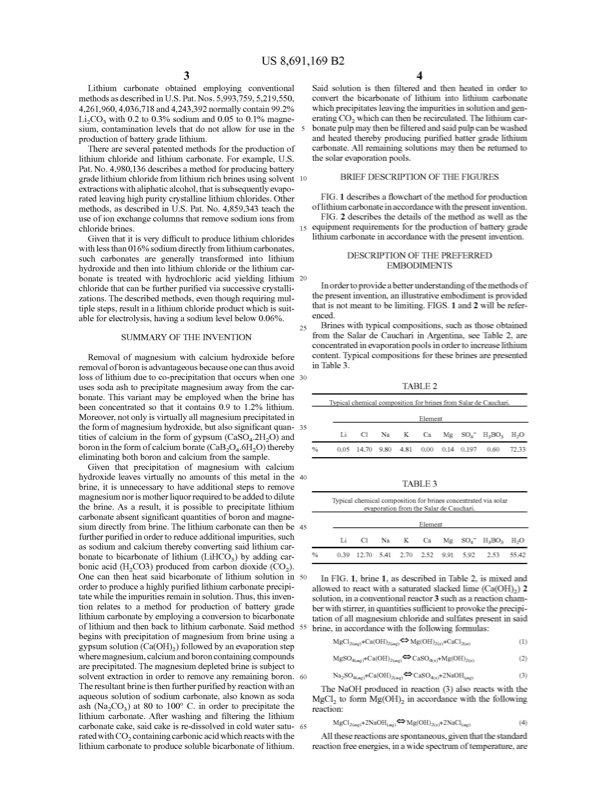
PDF Publication Title:
Text from PDF Page: 005
US 8,691,169B2 34 Lithium carbonate obtained employing conventional methodsasdescribedinU.S.Pat.Nos.5,993,759,5,219,550, 4.261,960,4,036,718and4.243,392normallycontain99.2% LiCOwith0.2to0.3%sodiumand0.05to0.1%magne sium,contaminationlevelsthatdonotallowforuseinthe productionofbaterygradelithium. Thereareseveralpatentedmethodsfortheproductionof lithiumchlorideandlithiumcarbonate.Forexample,U.S. Pat.No.4,980,136describesamethodforproducingbatery gradelithiumchloridefromlithiumrichbrinesusingsolvent extractionswithaliphaticalcohol,thatisSubsequentlyevapo ratedleavinghighpuritycrystalinelithiumchlorides.Other methods,asdescribedinU.S.Pat.No.4,859,343teachthe useofionexchangecolumnsthatremovesodiumionsfrom chloridebrines. Giventhatitisverydificulttoproducelithiumchlorides withlesthan0.16%sodiumdirectlyfromlithiumcarbonates, Such carbonates are generally transformed into lithium hydroxideandthenintolithiumchlorideorthelithiumcar bonateistreatedwithhydrochloricacidyieldinglithium chloridethatcanbefurtherpurifiedviasuccessivecrystali Zations.Thedescribedmethods,eventhoughrequiringmul tiplesteps,resultinalithiumchlorideproductwhichissuit ableforelectrolysis,havingasodiumlevelbelow0.06%. SUMMARY OF THE INVENTION 10 15 25 Said solution is then filtered and then heated in order to convert the bicarbonate of lithium into lithium carbonate whichprecipitatesleavingtheimpuritiesinSolutionandgen eratingCOwhichcanthenberecirculated.Thelithiumcar bonatepulpmaythenbefilteredandsaidpulpcanbewashed andheatedtherebyproducingpurifiedbatergradelithium carbonate.Allremainingsolutionsmaythenbereturnedto theSolarevaporationpols. BRIEF DESCRIPTION OF THE FIGURES FIG.1describesaflowchartofthemethodforproduction oflithiumcarbonateinaccordancewiththepresentinvention. FIG. 2 describes the details of the method as well as the equipmentrequirementsfortheproductionofbaterygrade lithiumcarbonateinaccordancewiththepresentinvention. DESCRIPTION OF THE PREFERRED EMBODIMENTS Inordertoprovideabeterunderstandingofthemethodsof thepresentinvention,anilustrativeembodimentisprovided thatisnotmeanttobelimiting.FIGS.1and2wilberefer enced. Brineswithtypicalcompositions,suchasthoseobtained fromtheSalardeCauchariinArgentina,seeTable2,are concentratedinevaporationpoolsinordertoincreaselithium content.Typicalcompositionsforthesebrinesarepresented inTable3. Removalofmagnesiumwithcalciumhydroxidebefore removalofboronisadvantageousbecauseonecanthusavoid losoflithiumduetoco-precipitationthatoccurswhenone usesSodaashtoprecipitatemagnesiumawayfromthecar bonate.Thisvariantmaybeemployedwhenthebrinehas been concentrated so that itcontains 0.9 to 1.2% lithium. Moreover,notonlyisvirtualyalmagnesiumprecipitatedin theformofmagnesiumhydroxide,butalsosignificantquan 35 titiesofcalciumintheformofgypsum(CaSO4.2H2O)and boronintheformofcalciumborate(CaBO.6H2O)thereby eliminatingbothboronandcalciumfromthesample. Given that precipitation of magnesium with calcium hydroxideleavesvirtualynoamountsofthismetalinthe40 brine,itisunnecessarytohaveaditionalstepstoremove magnesiumnorismotherliquorrequiredtobeaddedtodilute thebrine.Asaresult,itispossibletoprecipitatelithium carbonateabsentsignificantquantitiesofboronandmagne siumdirectlyfrombrine.Thelithiumcarbonatecanthenbe 45 furtherpurifiedinordertoreduceaditionalimpurities,such assodiumandcalciumtherebyconvertingsaidlithiumcar bonatetobicarbonateoflithium(LiHCO)byaddingcar bonicacid(HCO3)producedfromcarbondioxide(CO). One can then heat said bicarbonate of lithium solution in 50 ordertoproduceahighlypurifiedlithiumcarbonateprecipi tatewhiletheimpuritiesremaininsolution.Thus,thisinven tionrelatestoamethodforproductionofbaterygrade lithiumcarbonatebyemployingaconversiontobicarbonate oflithiumandthenbacktolithiumcarbonate.Saidmethod 55 beginswithprecipitationofmagnesiumfrombrineusinga gypsumsolution(Ca(OH))followedbyanevaporationstep wheremagnesium,calciumandboroncontainingcompounds areprecipitated.Themagnesiumdepletedbrineissubjectto Solventextractioninordertoremoveanyremainingboron. 60 Theresultantbrineisthenfurtherpurifiedbyreactionwithan aqueoussolutionofsodiumcarbonate,alsoknownasSoda ash(NaCO)at80to100°C.inordertoprecipitatethe lithiumcarbonate.Afterwashingandfilteringthelithium carbonatecake,saidcakeisre-dissolvedincoldwaterSatu 65 ratedwithCO containingcarbonicacidwhichreactswiththe lithiumcarbonatetoproducesolublebicarbonateoflithium. 30 % % TABLE 2 TypicalchemicalcompositionforbrinesfromSalardeCauchari. Element Li C Na K Ca Mg SO HBO HO O.OS 14.7O 9.80 4.81 O.OO O.14 O.197 0.60 72.33 TABLE 3 TypicalchemicalcompositionforbrinesconcentratedviaSolar evaporationfromtheSalardeCauchari. Element Li C Na K Ca Mg SO HBO H2O O.39 12.70 S.41 2.70 2.52 9.91 5.92 2.53 SS.42 InFIG.1,brine1,asdescribedinTable2,ismixedand allowedtoreactwithasaturatedslackedlime(Ca(OH)2)2 Solution,inaconventionalreactor3suchasareactioncham berwithstirer,inquantitiessuficienttoprovoketheprecipi tationofalmagnesiumchlorideandSulfatespresentinsaid brine,inaccordancewiththefollowingformulas: (3) TheNaOHproducedinreaction(3)alsoreactswiththe MgCl,toformMg(OH),inaccordancewiththefollowing reaction: Allthesereactionsarespontaneous,giventhatthestandard reactionfreenergies,inawidespectrumoftemperature,arePDF Image | Patent Production of Li from Industrial Brine

PDF Search Title:
Patent Production of Li from Industrial BrineOriginal File Name Searched:
US8691169.pdfDIY PDF Search: Google It | Yahoo | Bing
Product and Development Focus for Infinity Turbine
ORC Waste Heat Turbine and ORC System Build Plans: All turbine plans are $10,000 each. This allows you to build a system and then consider licensing for production after you have completed and tested a unit.Redox Flow Battery Technology: With the advent of the new USA tax credits for producing and selling batteries ($35/kW) we are focussing on a simple flow battery using shipping containers as the modular electrolyte storage units with tax credits up to $140,000 per system. Our main focus is on the salt battery. This battery can be used for both thermal and electrical storage applications. We call it the Cogeneration Battery or Cogen Battery. One project is converting salt (brine) based water conditioners to simultaneously produce power. In addition, there are many opportunities to extract Lithium from brine (salt lakes, groundwater, and producer water).Salt water or brine are huge sources for lithium. Most of the worlds lithium is acquired from a brine source. It's even in seawater in a low concentration. Brine is also a byproduct of huge powerplants, which can now use that as an electrolyte and a huge flow battery (which allows storage at the source).We welcome any business and equipment inquiries, as well as licensing our turbines for manufacturing.| CONTACT TEL: 608-238-6001 Email: greg@infinityturbine.com | RSS | AMP |